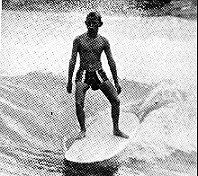surfresearch.com.au
 |
surfresearch.com.au
bob
mctavish : malibu repertoire, 1967
|
Bob
McTavish's
Complete Malibu Board Repertoire, circa 1966
By Bob McTavish
Surfing
World
Volume 8 Number 4 pages 15 to 21????
January 1967
(With additional images)
bob
mctavish
is in this wave.
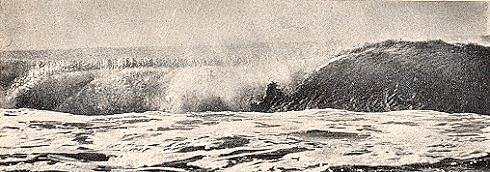
he probably had a
plan to get out of it
mctavish
explains:
Today's dynamic positive surfing
places
tremendous demands upon the surfer's initiative and ability.
He is pushed into some pretty tight
positions and he must pull himself out of them.
An expansive range of manoeuvres -
ranging from the obvious to the obscure, has evolved as a result
of this
trend to push things to the limit.
Progressive surfers are refining and
developing this range so rapidly that we figured it was time we
paused,
took a break, and reviewed our progress this far.
Here is a rundown of manoeuvres
that
are partially or fully adopted by the vanguard of Australia's
progressive
surfing push.
The direction is involvement.
Getting into tight spots and
getting
back out of them.
This is of course a supplement
direction
to the all powerful "make the wave" motive.
The way to get involved,
obviously,
is place yourself in a hairy position, under, in over,
around the
curl, quite often in contact with it.
You can place your self in the
actIon
in two basic methods, turning and stalling.
That's simple enough.
But the actual variety of turn or
stall
is the diary part.
Working firstly on turns:
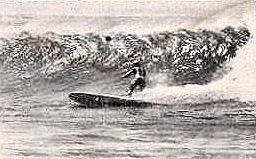 |
(a) DEEP BOTTOM TURN is
virtually
a stall, as you are holding back from travelling across
the wall till the
hook is hovering overhead.
When you actually lean into
the turn
there is a redirection of momentum gained by taking the
drop, so it's also
an obscure manner of acceleration.
Fig. 1 |
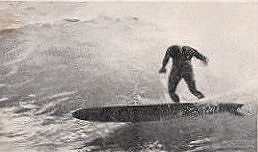 |
(b) CURL
ACCELERATION TURN is
virtually a bottom turn minus stall.
There is no wait while the
hook catches
up.
This turn then, must be
executed deeper,
sometimes following a fade into the hook.
The basic acceleration of
the bottom
turn is still there.
Fig. 2. |
|
(c) TOP RAIL PIVOT TURN,
used to get
hammering across the already hot wall, is hardly a turn
at all, just a
slight bank performed on the inside rail, on the widest
point of the board. |
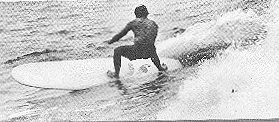 |
(d) CUT BACK followed by
one of the
above turns is a pretty obvious way to jam back into the
hook.
Fig. 13 |
The turns indicate
how
to get into the action from below, above, or behind the eye. But
to slip
back into the pocket from ahead? Employ one of the many stalls.
Try these.
 |
(a) THE TAIL STALL is the
oldest, most
obvious stall.
By jamming all your weight
on the back
half, or less, of your board, means you bury the in-
side half and fin
pretty deep, creating a mean drag.
The big hang-up with this
stall is
the acceleration that fol- lows, as it's a damn long way
to the fast points
from on the back.
Very handy of course to
allow you to
get to the tip, and hold the stall from there for a
while.
Fig. 3 |
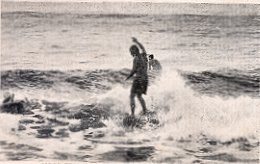 |
Which leads us to ...
(b) THE NOSE STALL.
To perform this, simply bury
the inside
rail while on the tip. Most noserides are performed this
way, but the stall
effect can be heightened by putting most weight on the
inside, which establishes
heavy drag down the entire rail.
Acceleration from here is a
snap. A
quick backpedal or sideslip to throw the board back into
instant trim.
Fig. 4. |
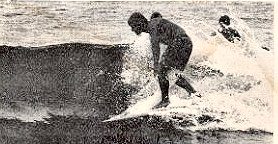 |
(c) DRAG BODY STALL is
obvious.
Just create a resistance by
getting
yourself smashed by the curl.
Fig. 5. |
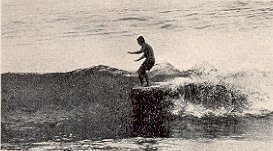 |
(d) BOUNCE OR CHOP STALL
can be performed
in any uneven conditions.
Any bounce or chop upsets
both trim
and break-away effect from rail by establishing
turbulence, hence drag.
Fig. 6. |
 |
(e) INSIDE RAIL ON FAST
POINT STALL
two-thirds towards the tip
is a safe
bet for speed on most boards.
It's a simple matter to
establish a
trim here, also simple to upset the trim by burying the
inside rail and
creating the usual drag.
Fig. 7. |
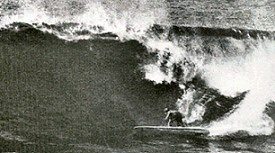 |
(f) FIN DROP-OUT STALL is
by far the
most efficient, most difficult.
If performed correctly, it
can eliminate
a cutback.
Everyone has experienced a
fin drop-out
and its main effect - loss of forward motion.
When emerging from a hot
hollow section
it's possible to remove the fin from the wave
intentionally, and establish
a sideways drift towards the beach. |
Perfect stall. No forward motion.
As the wave recovers and starts to
wall, drop the fin in by back-peddling, recover some sort of
trim, and
move out.
Nat Young and I spent two days at
Noosa
working on this, succeeded about four times each.
The big problem is knowing just when
the fin is going to break out.
We are working on special nose and
fin shapes for this purpose.
Fig. 14
Right: There are the various techniques
of getting
in the tight spots.
Get your jollies back in there, and
then try to get out, and make the wave.
To get out of the hot parts
you'll need
three things.
Acceleration, speed, knowledge of
handling
trouble spots.
A few handy acceleration
techniques.
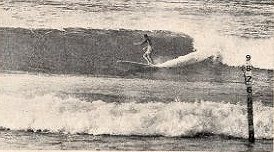 |
(a) WALKING OFF A
TURN.
Most surfers "safe it:' and
turn, allow
the board to climb, and then run forward. If you walk to
faster regions
of your board while you are finishing off your turn,
still banked, you
relieve the back of the board of your weight which
allows it to climb faster.
Also your weight keeps the
front lower,
creating a driving attitude much sooner.
Very little loss of
momentum.
Fig. 8. |
 |
(b) SIDE SLIPS can be
performed any-where
on the front half of the board.
They throw the board out of
an inside
rail stall, and set up a highly efficient trim for half
a second while
the board is banked outwards.
This half second or so
allows the board
to leap forward.
The acceleration is noticed
as soon
as the sideslip is checked, and the momentum gained from
the small drop
is redirected.
Fig. 9. |
|
(c) BACK PEDAL OFF TIP
onto fast point
is an obvious accelerator. |
|
(d) JUMPING INSIDE RAIL
OUT of the
wave face and dropping a couple of feet places the nose
lower than the
tail, again in a drive attitude.
Push an inside rail stall to
the limit,
where the board is horizontal, way out of trim, right at
the top of the
wave.
The only part of the board
still in
the wave will be the inside rail and a little piece of
fin.
A quick flicking action onto
the outside
rail and the board is virtually airborne.
As the rail re-enters, jam
your weight
onto the inside, once again there is a redirection of
momentum from a drop. |
|
(e) UTILIZING DROPPING
WHITE WATER
OR CURL employs the same principle as (d), but
instead of flicking the rail
out, employ
falling water to propel the drop.
This method can also be used
while
in trim on a hot wall.
Instead of back-pedalling
and destroying
trim to work around the section, just use the dropping
section itself to
accelerate you around it. |
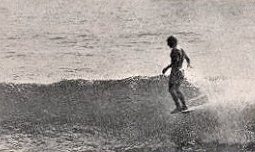 |
(f) WALKING TO THE TIP OUT
OF THE CURL
releases your legs and body from the resistance of the
falling curl.
Also places the back of the
board clear
of white water inside the curl, which means more
speed.
Fig. 10. |
Once you've
accelerated
into a screaming long wall, you'll want all possible speed.
 |
(a) OBVIOUS FAST POINT two
thirds from
back.
Fig.15
|
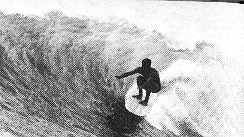 |
(b) FASTEST POINT is on
the tip on
the outside rail.
Very delicate. Very fast. So
far it's
only been used in small waves as an actual dive
position.
As we get touchier we'll use
it on
bigger waes. It is a great sensation, jammed up front
moving so fast it
doesn't feel right.
Very simple thing to dig
outside rai!
and get a board in the head.
Fig. 16 Joey
Cabell |
(c) A FEW TIPS.
Keep the
board clear of falling white water.
Go low through chop.
Crouch low in hard offshore winds.
All these things mean a little extra
when it's needed.
Speed itself isn't all that
important,
it's acceleration that makes the difference usually.
Knowledge.
Just when to accelerate. Just how to
get around trouble.
How to get out of it, too.
Here are a few assorted helpful
manoeuvres
which can be used to get out of dicey spots, or to get a little
more out
of a wave
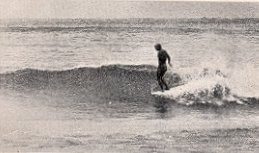 |
(a) WALKING TO TIP OUT OF
A PEARL transfers
more weight over a longer area of rail, hence drag,
which often will "suck"
the nose out of the pearl and place it up into the
wall.
Fig. 11. |
 |
(b) USING HEAD DIPS
AS A THIRD
POINT OF STABILITY.
Punching low under a
dropping section
and the dropping curl is exploding on the deck of your
board, upsetting
stability.
By throwing your head,
shoulders, arms,
hands into the curl you have a "solid" point, at least a
point of contact
to maintain balance.
Work your head up against
the curl,
your feet pushing the opposite direction, down hard,
onto the inside rail.
Helps avoid many bomb-outs.
Fig. 12. |
|
(c) USING THE HEAD DIP TO
BLOCK THE
CURL from crashing on the deck also means less downward
resistance. |
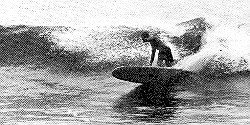 |
(e) POWERING TURNS AND
CUTBACKS OFF
CURLS AND WHITE WATER means faster turns, higher
manoeuvrability.
Fig. 18 |
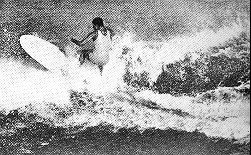 |
(f) CUT BACK "OVER THE
FALLS"
After wave has closed out,
or section
has dropped, take the drop with curl. Means you don't
get pummelled by
initial curl.
Fig. 19 Nat
Young |
Well there are the
actual
manoeuvres.
Selecting the instant to utilise
them
is up to you.
The tighter you push them, the
longer
you hold them, the more involved you are, the more situations
you can overcome,
the hotter you are.
Surfing World
Volume 8 Number 4 pages 15 to 21 ???
January 1967
Original photographs by John Witzig,
possibly
others.
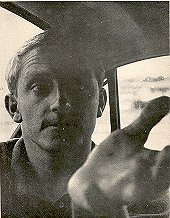
NOTES
The Text
Written late 1966 and published January
1967, the article is a comprehensivesive examination of
performance surfing,
circa 1966.
Within six
months
of this article, Bob McTavish (and others) would reduce
board lengths
from 9ft 6'' to 7ft 6'', rendering the Malibu board (and large
sections
of this article) obsolete for the next fifteen years.
Apart from the inclusion of state of
the
art manouvres (Fin Drop Out Stall and Cut Back Over the Falls),
it is the
re-defining of surfing direction that had a huge impact on
Australian surfing....
The direction is
involvement
...
a hairy position, under, in,
over,
around the curl, quite often in contact with it.
Modern surfing could be said to be
essentially
defined by this Involvement Principle and the subsequent BREAK
OUT FROM THE STAIGHT LINE. featured in "LADIES
AND
GENTLEMEN AND CHILDREN OF THE SUN...." SURF
INTERNATIONAL
Vol. 1. No. 2 1967-8? p 9.
The Images
The introductory wave (top - Wreck
Bay?),
portrait (bottom) and Figures 1 to 12 accompanied the original
article
and are probably by John Witzig.
Images 13 to 18 have been added to
this
page.
Where possible the images are of Bob
McTavish
or representative or the era.
Fig. 13
Bob McTavish cutback, Long Reef
circa 1967.
Photograph by Jeff Carter
Carter : Surfbeaches
of
Australia page 65
Fig. 14
Bob McTavish fin drop out
stall/side
slip, Duke Kahanamoku Contest, Sunset Beach December 1967.
Photograph by Dave Darling
i. The accompanying
image
may or may not be a controlled Fin Drop Out Stall.
The performance of the wide tailed
Vee
bottoms of Nat Young and Bob McTavish were derided by many
Hawaiian designers
ii. Explored by
Bob
McTavish and Nat Young in 1966, the Fin Drop Out Stall, was
briefly revisted
1969-70 by Reno Abellira in Hawaii and Midget Farrelly in
Australia with
the development of the Side Slipper.
iii. The Fin Drop Out Stall
returned
to surfing in the late 1980's when it was combined with a
Re-entry to produce
a Floater.
Accompanied article by Derek Hynd
about
Bob McTavish and the Vee bottom, Decemer 1967...
Plastic Fantastic Machine1967
Surfer
Magazine,
April 2002 Vol 43 No 5 page 60
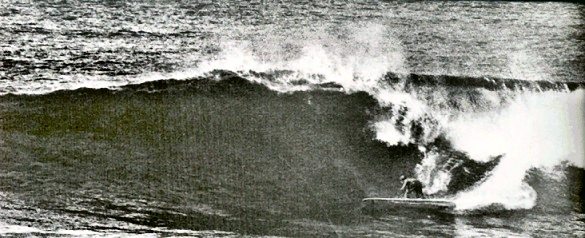
Fig. 15
Bob McTavish trim, National Park
Noosa, circa 1966.
Photograph by John Witzig
Carter : Surfbeaches
of
Australia page 100
Originally accompanied another Bob
McTavish
article
The
Wild and Wonderful Days of Noosa Part Two: "National"
Surfing World March 1967 pp 18
to 25.
Fig. 16
Joey Cabell maximum trim,
Angourie,
circa 1964.
Photograph possibly by Bob Evans
Farrelly : This
Surfing
Life page 38
Fig. 17
Kevin Brennan, North
Avalon,
circa 1964.
Photograph possibly by Bob Evans
Also called "bicycling", technically
the
image is not STRADDLING WHITE WATER.
Margan and Finney : Pictorial
History page 291
Fig. 18
Bob McTavish cutback
redirection,
Noosa, circa 1966.
Photograph probably by John Witzig
Accompanied another Bob McTavish
article
Alexandria
Headlands
1953.
SURF INTERNATIONAL Vol. 3 No3
1970
page 41
Fig. 19
Nat Young, Sydney, Australian
championships,
1968.
Photograph unknown
Descibed here as Cut Back
'Over
the Falls', this was to be subsequently become a
standard manourve
and named a Re-entry, Roller Coaster or Re-bound.
Margan and Finney : Pictorial
History page 212
McTavish, Bob: Bob McTavish is in this wave. He probably
had a plan to get out of it.
Surfing
World
Volume 8 Number 4, January 1967, pages 15 to 21?

surfresearch.com.au
Geoff
Cater (2001-214) : Bob McTavish : Malibu Repertoire, 1966.
http://www.surfresearch.com.au/1967_McT_How_To_SW_Jan.html


















